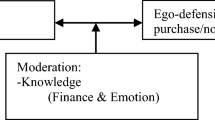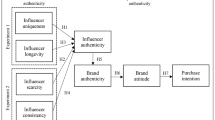Abstract
We posit and show that some consumers may remain brand loyal because of their motivation to conform; in contrast, others may do so because of their motivation to break away. Furthermore, we identify two central moderating variables – product knowledge and self-image congruence – that determine how conformity or escapism motivation affects brand loyalty. We show that these common communication goals play an asymmetric role for each motive. In particular, self-image congruence is found to enhance brand loyalty for consumers who are motivated to conform, but not for those who are driven to escape. Alternatively, product knowledge is found to enhance brand loyalty for escapism-motivated consumers, but inhibits brand loyalty for consumers who are bound to conform. Given that both moderators are central to most brand-related marketing communication, the insights of this study will help brand managers better understand the impact of communication goals on brand loyalty and ultimately marketing performance.



Similar content being viewed by others
References
Aiken, L.S. and West, S.G. (1991) Multiple Regression: Testing and Interpreting Interactions. Thousand Oaks, CA: Sage Publications.
Bagozzi, R.P. and Yi, Y. (1988) On the evaluation of structural equation models. Journal of the Academy of Marketing Science 16 (1): 74–94.
Bearden, W.O. and Etzel, M.J. (1982) Reference group influence on product and brand purchase decisions. Journal of Consumer Research 9 (2): 183–194.
Bearden, W.O., Netemeyer, R.G. and Teel, J.E. (1989) Measurement of consumer susceptibility to interpersonal influence. Journal of Consumer Research 15 (4): 473–481.
Belk, R.W. and Tumbat, G. (2005) The cult of the Macintosh. Consumption, Markets and Culture 8 (3): 205–217.
Bosnjak, M. and Rudolph, N. (2008) Undesired self-image congruence in a low-involvement product context. European Journal of Marketing 42 (5/6): 702–712.
Chaplin, D. (1999) Consuming work/productive leisure: The consumption patterns of second home environments. Leisure Studies 18 (1): 41–55.
Churchill Jr, G.A. (1979) A paradigm for developing better measures of marketing constructs. Journal of Marketing Research 16: 64–73.
Cialdini, R.B., Levy, A., Herman, C.P., Kozlowski, L.T. and Petty, R.E. (1976) Elastic shifts of opinion: Determinants of direction and durability. Journal of Personality and Social Psychology 34: 663–672.
Cialdini, R.B. and Trost, M.R. (1998) Social influence: Social norms, conformity, and compliance. In: D.T. Gilbert, S.T. Fiske and G. Lindzey (eds.) The Handbook of Social Psychology. Boston, MA: McGraw-Hill, pp. 151–192.
Cohen, S. and Taylor, L. (1992) Escape Attempts: The Theory and Practice of Resistance to Everyday Life. London: Routledge.
Csikszentmihalyi, M. (2000) The costs and benefits of consuming. Journal of Consumer Research 27 (2): 267–272.
Darke, P.R., Chaiken, S., Bohner, G., Einwiller, S., Erb, H.P. and Hazelwood, J.D. (1998) Accuracy motivation, consensus information, and the law of large numbers: Effects on attitude judgment in the absence of argumentation. Personality and Social Psychology Bulletin 24: 1205–1215.
Epstein, S. (1990) Cognitive-experiential self-theory. In: L.A. Pervin (ed.) Handbook of Personality Theory and Research. New York: Guilford Press, pp. 165–192.
Escalas, J.E. and Bettman, J.R. (2005) Self-construal, reference groups, and brand meaning. Journal of Consumer Research 32 (3): 378–389.
Firat, A.F. and Venkatesh, A. (1995) Libratory postmodernism and the reenchantment of consumption. Journal of Consumer Research 22 (3): 239–267.
Fiske, S.T. (2004) Social Beings: Core Motives Approach to Social Psychology. New York: Wiley.
Fornell, C. and Larcker, D.F. (1981) Structural equation models with unobservable variables and measurement error: Algebra and statistics. Journal of Marketing Research 18 (3): 382–388.
Fournier, S. (1998) Consumers and their brands: Developing relationship theory in consumer research. Journal of Consumer Research 24 (4): 343–373.
Gerbing, D.W. and Anderson, J.C. (1988) An updated paradigm for scale development incorporating unidimensionality and its assessment. Journal of Marketing Research 25 (2): 186–192.
Hausman, A.V. and Siekpe, J.S. (2009) The effect of web interface features on consumer online purchase intentions. Journal of Business Research 62 (1): 5–13.
Henry, P.C. and Caldwell, M. (2006) Self-empowerment and consumption. European Journal of Marketing 40 (9/10): 1031–1048.
Hirschman, E.C. (1983) Predictors of self-projection, fantasy fulfillment, and escapism. The Journal of Social Psychology 120: 63–76.
Hirschman, E.C. (1992) The consciousness of addiction: Toward a general theory of compulsive consumption. Journal of Consumer Research 19 (2): 155–179.
Holt, D.B. (1995) How consumers consume: A typology of consumption practices. Journal of Consumer Research 22 (1): 1–16.
Johar, J.S. and Sirgy, M.J. (1991) Value-expressive versus utilitarian advertising appeals: When and why to use which appeal. Journal of Advertising 20 (3): 23–33.
Kahle, L.R. (1995) Observations: Role-relaxed consumers: A trend of the nineties. Journal of Advertising Research 35 (2): 66–71.
Korgaonkar, P.K. and Wolin, L.D. (1999) A multivariate analysis of web usage. Journal of Advertising Research 39 (2): 53–68.
Kozinets, R.V. (2002) Can consumers escape the market? Emancipatory illuminations from burning man. Journal of Consumer Research 29 (1): 20–38.
Kressmann, F., Sirgy, M.J., Herrmann, A., Huber, F., Huber, S. and Lee, D.J. (2006) Direct and indirect effects of self-image congruence on brand loyalty. Journal of Business Research 59 (9): 955–964.
Krueger, J. (1998) On the perception of social consensus. Advances in Experimental Social Psychology 30: 163–240.
Lichtenstein, D.R., Netemeyer, R.G. and Burton, S. (1990) Distinguishing coupon proneness from value consciousness: An acquisition-transaction utility theory perspective. Journal of Marketing 54 (3): 54–67.
Mason, C.H. and Perreault Jr, W.D. (1991) Collinearity, power, and interpretation of multiple regression analysis. Journal of Marketing Research 28 (3): 268–280.
Mathwick, C. and Rigdon, E. (2004) Play, flow, and the online search experience. Journal of Consumer Research 31 (2): 324–332.
McAlexander, J.H., Schouten, J.W. and Koenig, H.F. (2002) Building brand community. Journal of Marketing 66 (1): 38–54.
Miniard, P.W. and Cohen, J.B. (1983) Modeling personal and normative influences on behavior. Journal of Consumer Research 10 (2): 169–180.
Muniz Jr, A.M. and O'Guinn, T.C. (2001) Brand community. Journal of Consumer Research 27 (4): 412–432.
Nunnally, J.C. (1994) Psychometric Theory. New York: McGraw-Hill.
Oliver, R.L. (1999) Whence consumer loyalty? Journal of Marketing 63: 33–44.
Ouwersloot, H. and Odekerken-Schröder, G. (2008) Who's who in brand communities – And why? European Journal of Marketing 42 (5/6): 571–585.
Park, C.W., Jaworski, B.J. and Maclnnis, D.J. (1986) Strategic brand concept-image management. Journal of Marketing 50 (4): 135–145.
Petty, R.E. and Cacioppo, J.T. (1986) Communication and Persuasion: Central and Peripheral Routes to Attitude Change. New York: Springer-Verlag.
Pham, M.T., Cohen, J.B., Pracejus, J.W. and Hughes, G.D. (2001) Affect monitoring and the primacy of feelings in judgment. Journal of Consumer Research 28 (2): 167–188.
Rojek, C. (1993) Ways of Escape: Modern Transformations in Leisure and Travel. London: Macmillan Press.
Ross, L., Greene, D. and House, P. (1977) The ‘false consensus effect’: An egocentric bias in social perception and attribution processes. Journal of Experimental Social Psychology 13: 279–301.
Rottenstreich, Y., Sood, S. and Brenner, L. (2007) Feeling and thinking in memory-based versus stimulus-based choices. Journal of Consumer Research 33 (4): 461–469.
Schouten, J.W. and McAlexander, J.H. (1995) Subcultures of consumption: An ethnography of the new bikers. Journal of Consumer Research 22 (1): 43–61.
Shiv, B. and Fedorikhin, A. (1999) Heart and mind in conflict: The interplay of affect and cognition in consumer decision making. Journal of Consumer Research 26 (3): 278–292.
Sirgy, M.J. (1997) Assessing the predictive validity of two methods of measuring self-image congruence. Journal of the Academy of Marketing Science 25 (3): 229–242.
Sirgy, M.J., Lee, D., Johar, J.S. and Tidwell, J. (2008) Effect of self-congruity with sponsorship on brand loyalty. Journal of Business Research 61 (10): 1091–1097.
Slater, A. (2007) Escaping to the gallery: Understanding the motivations of visitors to galleries. International Journal of Nonprofit and Voluntary Sector Marketing 12 (2): 149–162.
Spivey, W.A., Munson, J.M. and Locander, W.B. (1983) Improving the effectiveness of persuasive communications: Matching message with functional profile. Journal of Business Research 11 (2): 257–269.
Vorauer, J.D. and Miller, D.T. (1997) Failure to recognize the effect of implicit social influence on the presentation of self. Journal of Personality and Social Psychology 73: 281–295.
Wann, D.L., Allen, B. and Rochelle, A.R. (2004) Using sports fandom as an escape: Searching for relief from under-stimulation and over-stimulation. International Sports Journal 8 (1): 104–113.
Winchester, M., Romaniuk, J. and Bogomolova, S. (2008) Positive and negative brand beliefs and brand defection/uptake. European Journal of Marketing 42 (5/6): 553–570.
Wood, W. (2000) Attitude change: Persuasion and social influence. Annual Review of Psychology 51 (1): 539–570.
Author information
Authors and Affiliations
APPENDIX
APPENDIX
Scale items and reliability (Cronbach's α)
All items measured on five-point Likert scales anchored strongly disagree (1) to strongly agree (5).
Loyalty α=0.87
How often do you use your iPod?
-
1
I am a ‘regular’ iPod user.
-
2
I use the iPod very frequently.
-
3
I always use my iPod.
Do you believe the iPod offers value?
-
1
My iPod is the best.
-
2
The iPod is of high quality.
-
3
Buying the iPod will always satisfy my needs.
Would you go out of your way to use your iPod?
-
1
I would not switch music players even if it was more convenient.
-
2
I would pay more for an iPod than for other music players.
-
3
I would go out of my way to use the iPod.
Escapism motivation α=0.91
-
1
I use my iPod so I can escape from reality.
-
2
I use my iPod because it stirs me up.
-
3
I use my iPod because it arouses my emotions and feelings.
-
4
I use my iPod because it makes me feel less lonely.
-
5
I use my iPod because it takes me into another world.
Conformity motivation α=0.74
-
1
It is important that others think well of how I dress and look.
-
2
When I am uncertain how to act in a social situation, I try to do what others are doing.
-
3
My friends and I tend to buy the same brands.
Self-image congruity α=0.91
Do the typical people who buy iPods match how you see yourself?
-
1
I can identify myself with the people who own iPods.
-
2
The typical person who owns an iPod matches how I see myself.
-
3
The image of the iPod brand is consistent with my self-image.
Do the typical people who buy iPod match how you like to see yourself?
-
1
People who own iPods are like the person that I like to be.
-
2
I aspire to be like those who use iPods.
-
3
The typical person who uses iPods matches how I like to see myself.
Product knowledge α=0.90
-
1
I feel very knowledgeable about the iPod.
-
2
If friends asked me about MP3 players, I could give them advice about different brands.
-
3
I feel very confident about my ability to tell the difference in quality among different MP3 players.
-
4
I have a lot of knowledge about how to select the best brand of MP3 players to suit my needs.
Rights and permissions
About this article
Cite this article
Labrecque, L., Krishen, A. & Grzeskowiak, S. Exploring social motivations for brand loyalty: Conformity versus escapism. J Brand Manag 18, 457–472 (2011). https://doi.org/10.1057/bm.2011.12
Received:
Revised:
Published:
Issue Date:
DOI: https://doi.org/10.1057/bm.2011.12




